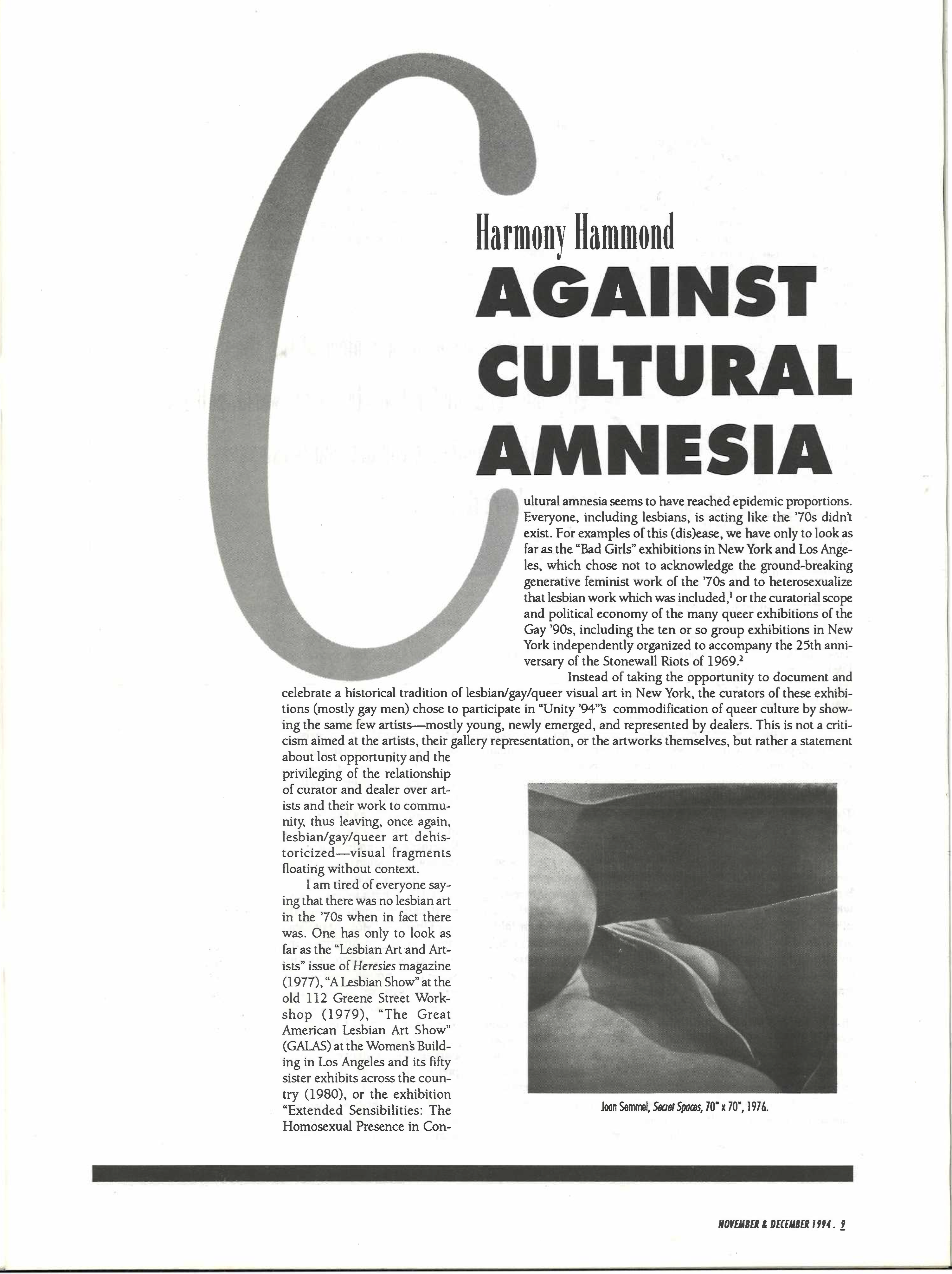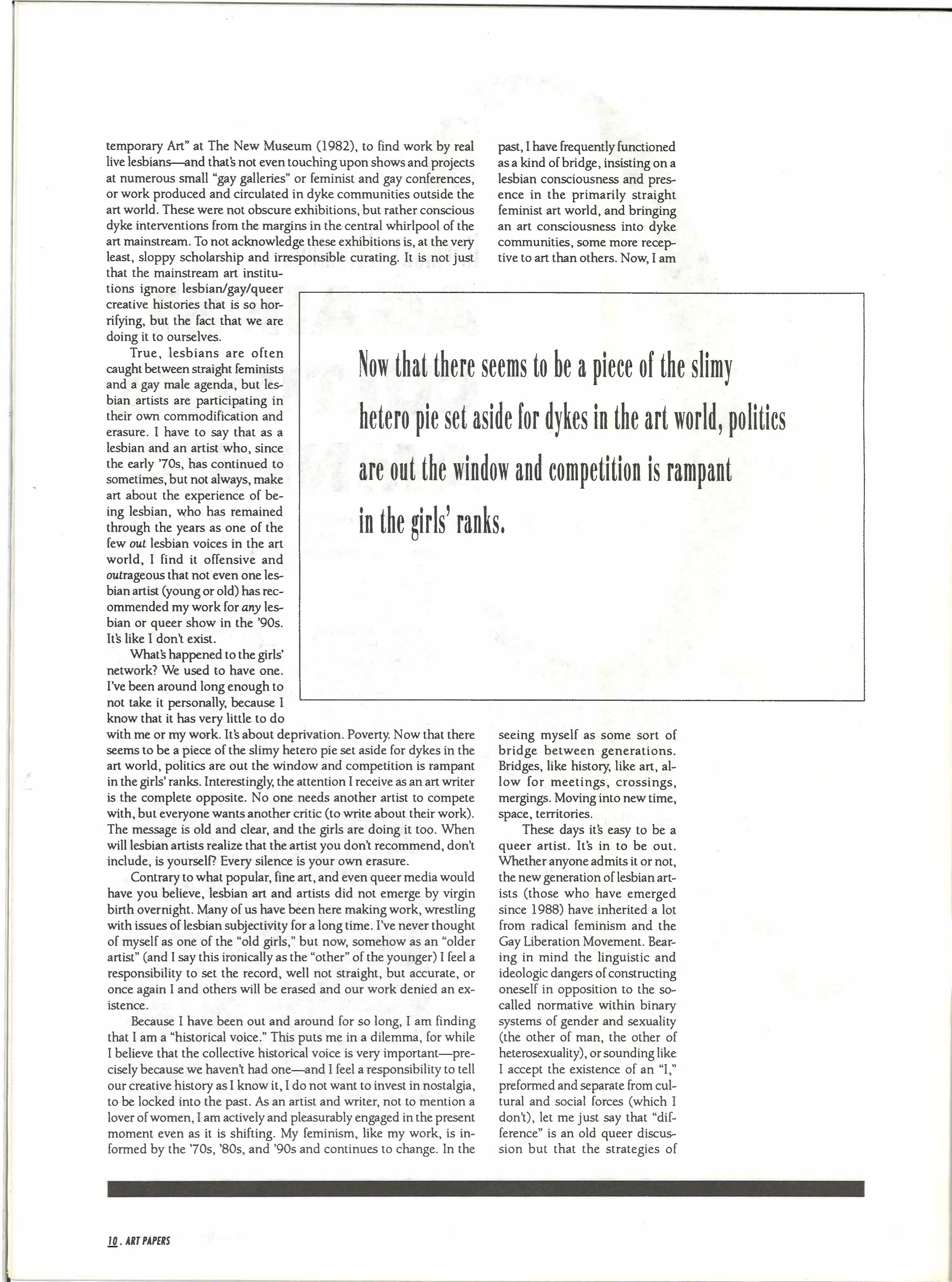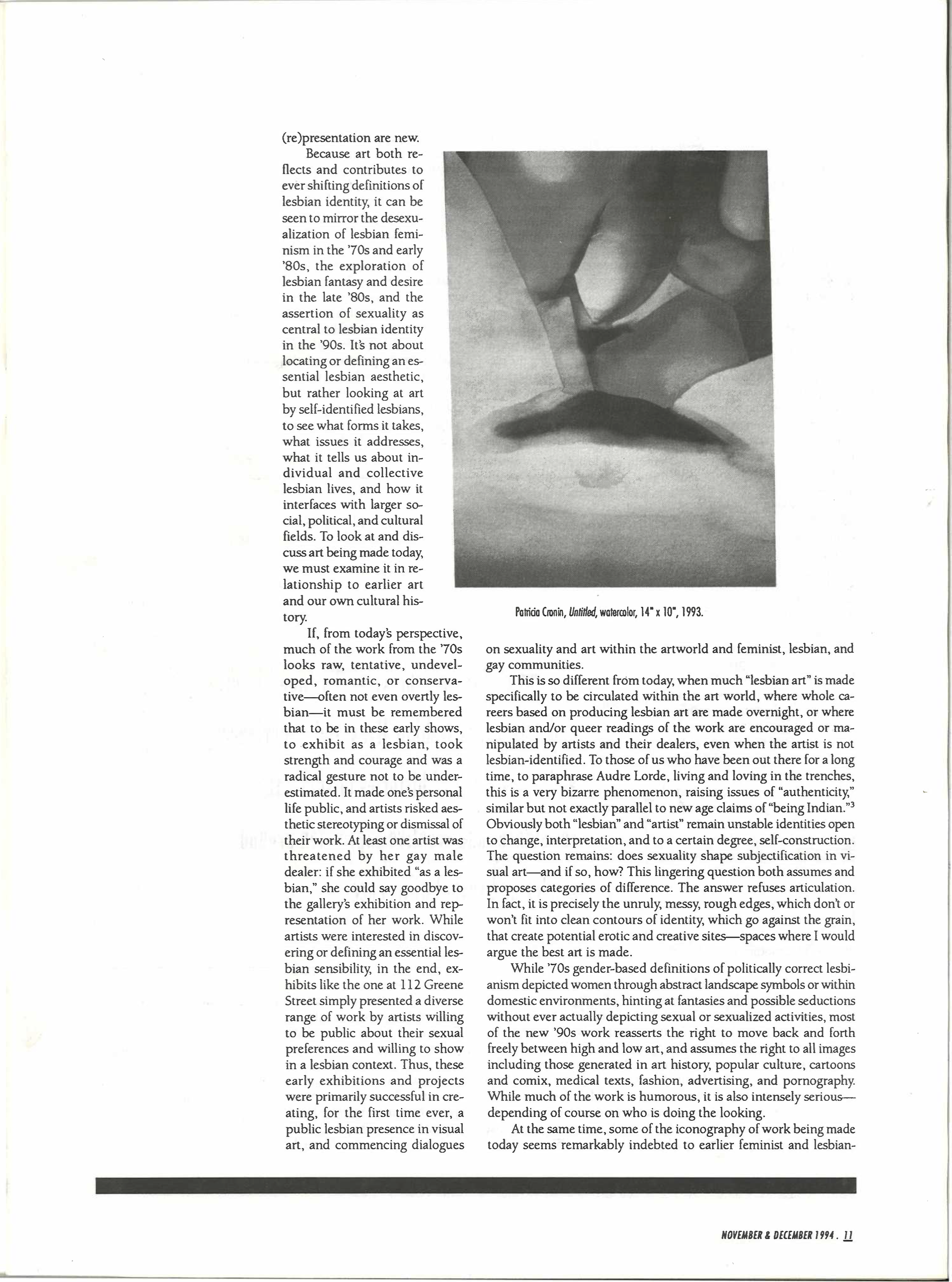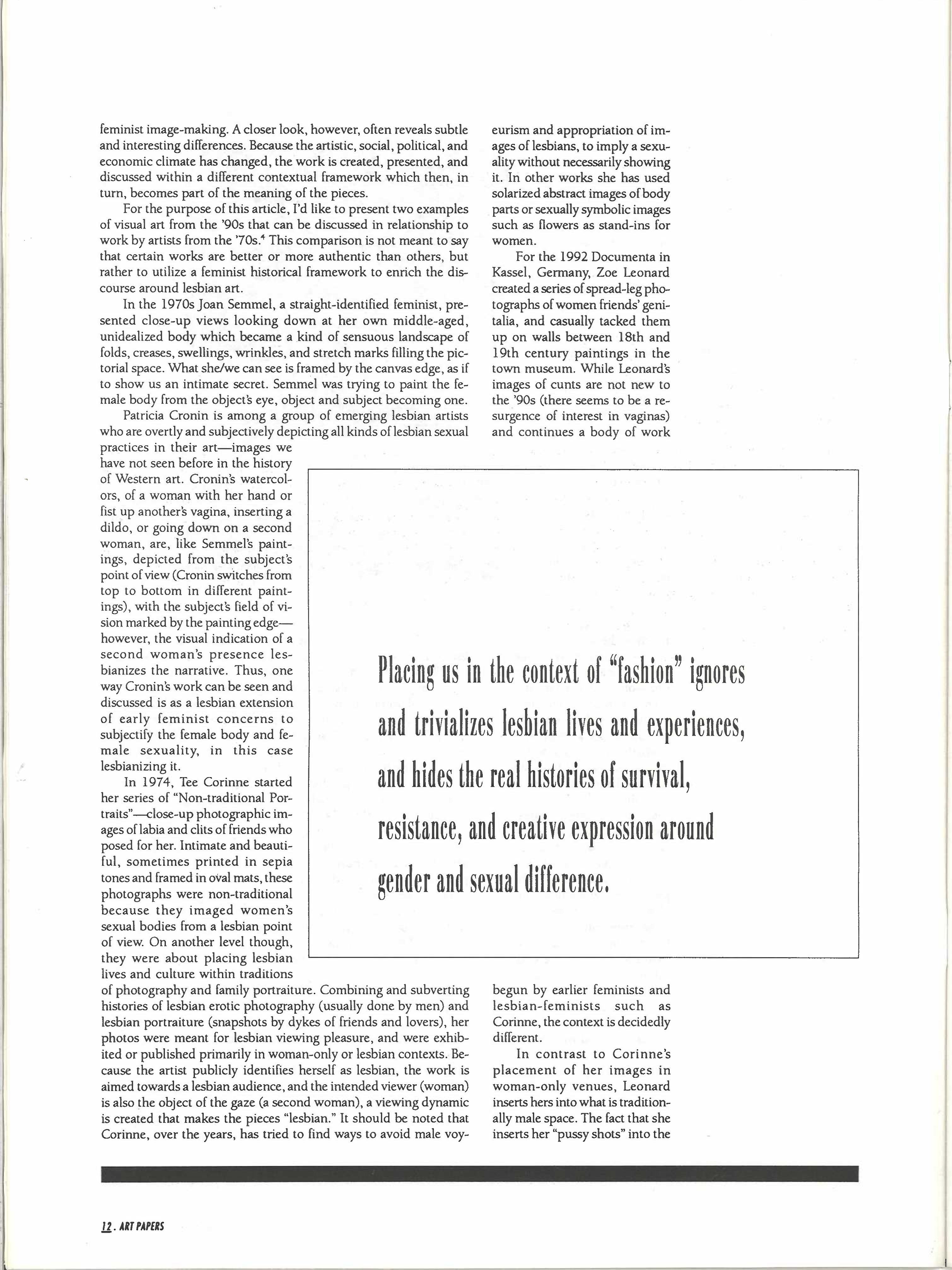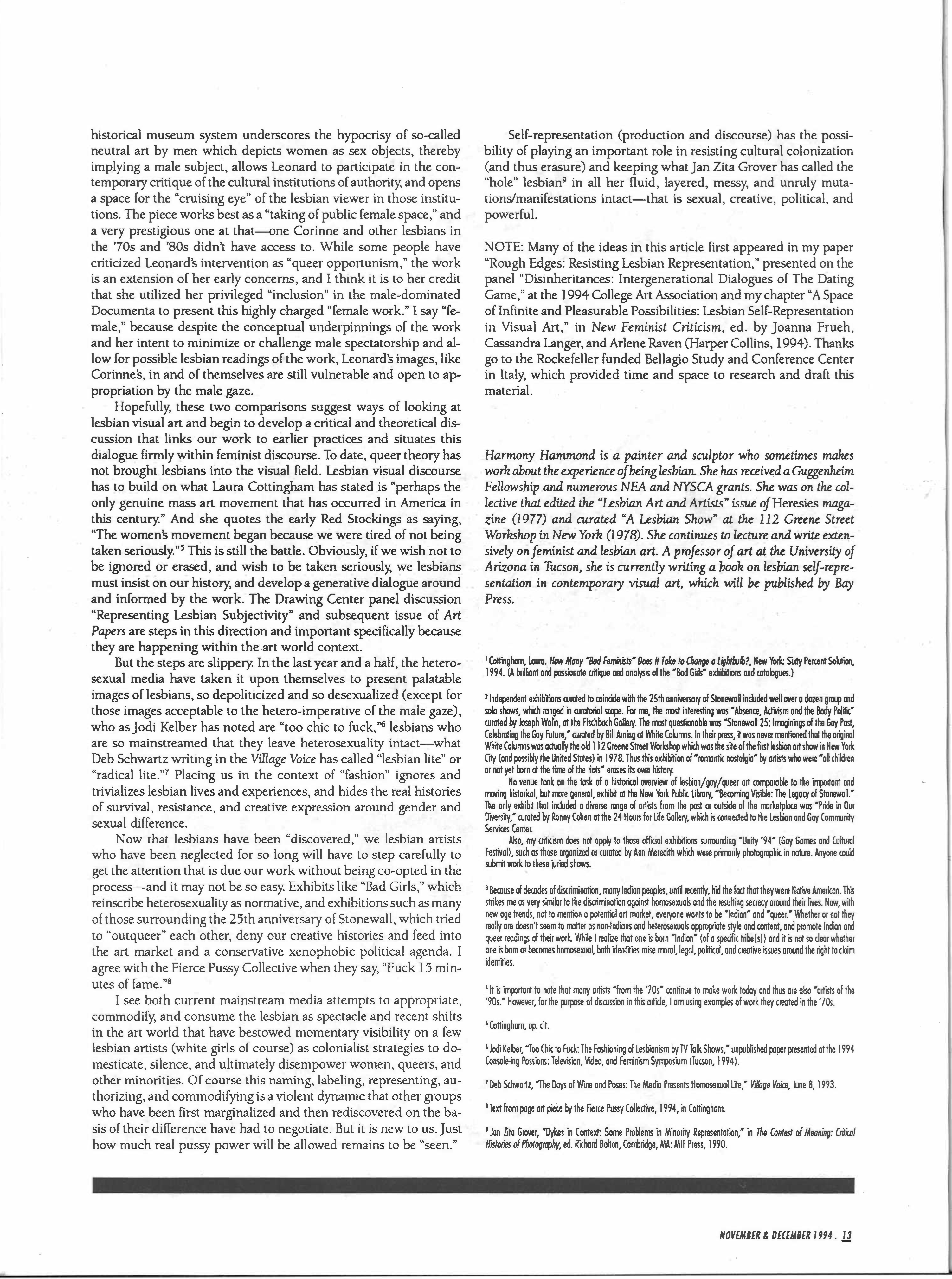Against Cultural Amnesia
Share:
This feature originally appeared in ART PAPERS November/December 1994
Cultural amnesia seems to have reached epidemic proportions. Everyone, including lesbians, is acting like the ’70s didn’t exist. For examples of this (dis)ease, we have only to look as far as the “Bad Girls” exhibitions in New York and Los Angeles, which chose not to acknowledge the ground-breaking generative feminist work of the ‘70s and to heterosexualize that lesbian work which was included,1 or the curatorial scope and political economy of the many queer exhibitions of the Gay ‘90s, including the ten or so group exhibitions in New York independently organized to accompany the 25th anniversary of the Stonewall Riots of 1969.2
Instead of taking the opportunity to document and celebrate a historical tradition of lesbian/gay/queer visual art in New York, the curators of these exhibitions (mostly gay men) chose to participate in “Unity ‘94”s commodification of queer culture by showing the same few artists – mostly young, newly emerged, and represented by dealers. This is not a criticism aimed at the artists, their gallery representation, or the artworks themselves, but rather a statement about lost opportunity and the privileging of the relationship of curator and dealer over artists and their work to community, thus leaving, once again, lesbian/gay/queer art dehistoricized – visual fragments floating without context.
I am tired of everyone saying that there was no lesbian art in the ‘70s when in fact there was. One has only to look as far as the “Lesbian Art and Artists” issue of Heresies magazine (1977), “A Lesbian Show” at the old 112 Greene Street Workshop (1979), “The Great American Lesbian Art Show” (GALAS) at the Women’s Building in Los Angeles and its fifty sister exhibits across the country (1980), or the exhibition “Extended Sensibilities: The Homosexual Presence in Contemporary Art” at the New Museum (1982), to find work by real live lesbians – and that’s not even touching upon shows and projects at numerous small “gay galleries” or feminist and gay conferences, or work produced and circulated in dyke communities outside the art world. These were not obscure exhibitions, but rather conscious dyke interventions from the margins in the central whirlpool of the art mainstream. To not acknowledge these exhibitions is, at the very least, sloppy scholarship and irresponsible curating. It is not just that the mainstream art institutions ignore lesbian/gay/queer creative histories that is so horrifying, but the fact that we are doing it to ourselves.
True, lesbians are often caught between straight feminists and a gay male agenda, but lesbian artists are participating in their own commodification and erasure. I have to say that as a lesbian and an artist who, since the early 70s, has continued to sometimes, but not always, make art about the experience of being lesbian, who has remained through the years as one of the few out lesbian voices in the art world, I find it offensive and outrageous that not even one lesbian artist (young or old) has recommended my work for any lesbian or queer show in the ‘90s. It’s like I don’t exist.
What’s happened to the girls’ network? We used to have one. I’ve been around long enough to not take it personally, because I know that it has very little to do with me or my work. It’s about deprivation. Poverty. Now that there seems to be a piece of the slimy hetero pie and competition is rampant in the girls’ ranks. Interestingly, the attention I receive as an art writer is the complete opposite. No one needs another artist to compete with, but everyone wants another critic (to write about their work). The message is old and clear, and the girls are doing it too. When will lesbian artists realize that the artist you don’t recommend, don’t include, is yourself? Every silence is your own erasure.
Contrary to what popular, fine art, and even queer media would have you believe, lesbian art and artists did not emerge by virgin birth overnight. Many of us have been here making work, wrestling with issues of lesbian subjectivity for a long time. I’ve never thought of myself as one of the “old girls,”, but now, somehow as an “older artist” (and I say this ironically as the “other of the younger) I feel a responsibility to set the record, well not straight, but accurate, or once again I and others will be erased and our work denied an existence.
Because I have been out and around for so long, I am finding that I am a “historical voice.” This puts me in a dilemma, for while I believe that the collective historical voice is very important – precisely because we haven’t had one – and I feel a responsibility to tell our creative history as I know it, I do not want to invest in nostalgia, to be locked into the past. As an artist and a writer, not to mention a lover of women, I am actively and pleasurably engaged in the present moment even as it is shifting. My feminism, like my work, is informed by the ‘70s, ‘80s, and ‘90s and continues to change. In the past, I have frequently functioned as a kind of bridge, insisting on a lesbian consciousness and presence in the primarily straight feminist art world, and bringing an art consciousness into dyke communities, some more receptive to art than others. Now, I am seeing myself as some sort of bridge between generations. Bridges, like history, like art, allow for meetings, crossings, mergings. Moving into new time, space, territories.
These days it’s easy to be a queer artist. It’s in to be out. Whether anyone admits it or not, the new generation of lesbian artists (those who have emerged since 1988) have inherited a lot from radical feminism and the Gay Liberation Movement. Bearing in mind the linguistic and ideologic dangers of constructing oneself in opposition to the so-called normative within binary systems of gender and sexuality (the other of man, the other of heterosexuality), or sounding like I accept the existence of an “I,” preformed and separate from cultural and social forces (which I don’t), let me just say that “difference” is an old queer discussion but that the strategies of (re)presentation are new.
Because art both reflects and contributes to ever shifting definitions of lesbian identity, it can be seen to mirror the desexualization of lesbian feminism in the ‘70s and early ‘80s, and the assertion of sexuality as central to lesbian identity in the ‘90s. It’s not about locating or defining an essential lesbian aesthetic, but rather looking at art by self-identified lesbians, to see what forms it takes, what issues it addresses, what it tells us about individual and collective lesbian lives, and how it interfaces with larger social, political, and cultural fields. To look at and discuss art being made today, we must examine it in relationship to earlier art and our own cultural history.
If, from today’s perspective, much of the work from the ‘70s looks raw, tentative, undeveloped, romantic, or conservative – often not even overtly lesbian – it must be remembered that to be in these early shows, to exhibit as a lesbian, took strength and courage and was a radical gesture not to be underestimated. It made one’s personal life public, and artists risked aesthetic stereotyping or dismissal of their work. At least one artist was threatened by her gay male dealer: if she exhibited “as a lesbian,” she could say goodbye to the gallery’s exhibition and representation of her work. While artists were interested in discovering or defining an essential lesbian sensibility, in the end, exhibits like the one at 112 Greene Street simply presented a diverse range of work by artists willing to be public about their sexual preferences and willing to show in a lesbian context. Thus, these early exhibitions and projects were primarily successful in creating, for the first time ever, a public lesbian presence in a visual art, and commencing dialogues on sexuality and art within the artworld and feminist, lesbian, and gay communities.
This is so different from today, when much “lesbian art” is made specifically to be circulated within the art world, where whole careers based on producing lesbian art are made overnight, or where lesbian and/or queer readings of the work are encouraged or manipulated by artists and their dealers, even when the artist is not lesbian-identified. To those of us who have been out there for a long time, to paraphrase Audre Lorde, living and loving in the trenches, this is a very bizarre phenomenon, raising issues of “authenticity,” similar but not exactly parallel to new age claims of “being Indian.”3 Obviously both “lesbian” and “artist” remain unstable identities open to change, interpretation, and to a certain degree, self-construction. The question remains: does sexuality shape subjectification in visual art – and if so, how? This lingering question both assumes and proposes categories of difference. The answer refuses articulation. In fact, it is precisely the unruly, messy, rough edges, which don’t or won’t fit into clean contours of identity, which go against the grain, that clean potential erotic and creative sites – spaces where I would argue the best art is made.
While ‘70s gender-based definitions of politically correct lesbianism depicted women through abstract landscape symbols or within domestic environments, hinting at fantasies and possible seductions without ever actually depicting sexual or sexualized activities, most of the new ‘90s work reasserts the right to move back and forth freely between high and low art, and assumes the right to all images including those generated in art history, popular culture, cartoons and comix, medical texts, fashion, advertising, and pornography. While much of the work is humorous, it is also intensely serious – depending of course on who is doing the looking.
At the same time, some of the iconography of work being made today seem remarkably indebted to earlier feminist and lesbian feminist image-making. A closer look, however, often reveals subtle and interesting differences. Because the artistic, social, political, and economic climate has changed, the work is created, presented, and discussed within a different contextual framework which then, in turn, becomes part of the meaning of the pieces.
For the purpose of this article, I’d like to present two examples of visual art from the ‘90s that can be discussed in relationship to work by artists from the ‘70s.4 This comparison is not meant to say that certain works are better or more authentic than others, but rather to utilize a feminist historical framework to enrich the discourse around lesbian art.
In the 1970s Joan Semmel, a straight-identified feminist, presented close-up views looking down at her own middle-aged, unidealized body which became a kind of sensuous landscape of folds, creases, swellings, wrinkles, and stretch marks filling the pictorial space. What she/we can see is framed by the canvas edge, as if to show us an intimate secret. Semmel was trying to paint the female body from the object’s eye, object and subject becoming one.
Patricia Cronin is among a group of emerging lesbian artists who are overtly and subjectively depicting all kinds of lesbian sexual practices in their art – images we have not seen before in the history of Western art. Cronin’s watercolors, of a woman with her hand or fist up another’s vagina, inserting a dildo, or going down on a second woman, are, like Semmel’s paintings, depicted from the subject’s point of view (Cronin switches from top to bottom in different paintings), with the subject’s field of vision marked by the painting’s edge – however, the visual indication of a second woman’s presence lesbianizes the narrative. Thus, one way Cronin’s work can be seen and discussed is as a lesbian extension of early feminist concerns to subjectify the female body and female sexuality, in this case lesbianizing it.
In 1974, Tee Corinne started her series of “Non-traditional Portraits” – close-up photographic images of labia and clits of friends who posed for her. Intimate and beautiful, sometimes printed in sepia tones and framed in oval mats, these photographs were non-traditional because they imaged women’s sexual bodies from a lesbian point of view. On another level though, they were about placing lesbian lives and culture within traditions of photography and family portraiture. Combining and subverting histories of lesbian erotic photography (snapshots by dykes of friends and lovers), her photos were meant for lesbian viewing pleasure, and were exhibited or published primarily in woman-only or lesbian contexts. Because the artist publicly identifies herself as lesbian, the work is aimed towards a lesbian audience, and the intended viewer (woman) is also the object of the gaze (a second woman), a viewing dynamic is created that makes the pieces “lesbian.” It should be noted that Corinne, over the years, has tried to find ways to avoid male voyeurism and appropriation of images of lesbians, to imply a sexuality without necessarily showing it. In other works she has used solarized abstract images of body parts or sexually symbolic images such as flowers as stand-ins for women.
For the 1992 Documenta in Kassel, Germany, Zoe Leonard created a series of spread-leg photographs of women friends’ genitalia, and casually tacked them up on walls between 18th and 19th century paintings in the town museum. While Leonard’s images of cunts are not new to the ‘90s (there seems to be a resurgence of interest in vaginas) and continues a body of work begun by earlier feminists and lesbian-feminists such as Corinne, the context is decidedly different.
In contrast to Corinne’s placement of her images in woman-only venues, Leonard inserts hers into what is traditionally male space. The fact that she inserts her “pussy shots” into the historical museum system underscores the hypocrisy of so-called neutral art by men which depicts women as sex objects, thereby implying a male subject, allows Leonard to participate in the contemporary critique of the cultural institutions of authority, and opens a space for the “cruising eye” of the lesbian viewer in those institutions. The piece works best as a “taking of public female space,” and a very prestigious one at that – one Corinne and other lesbians in the ’70s and ’80s didn’t have access to. While some people have criticized Leonard’s intervention as “queer opportunism, “the work is an extension of her early concerns, and I think it is to her credit that she utilized her privileged “inclusion” in the male-dominated Documenta to present this highly charged “female work.” I say “female, “because despite the conceptual underpinnings of the work and her intent to minimize or challenge male spectatorship and allow for possible lesbian readings of the work, Leonard’s images, like Corinne’s, in and of themselves are still vulnerable and open to appropriation by the male gaze.
Hopefully, these two comparisons suggest ways of looking at lesbian visual art and begin to develop a critical and theoretical discussions that links our work to earlier practices and situates this dialogue firmly within feminist discourse. To date, queer theory has not brought lesbians into the visual field. Lesbian visual discourse has to build on what Laura Cottingham has stated is “perhaps the only genuine mass art movement that has occurred in America in this century.” And she quotes the early Red Stockings as saying, “The women’s movement began because we were tired of not being taken seriously.”5 This is still the battle. Obviously, if we wish not to be ignored or erased, and wish to be taken seriously, we lesbians must insist on our history, and develop a generative dialogue around and informed by the work. The Drawing Center panel discussion “Representing Lesbian Subjectivity” and subsequent issue of Art Papers are steps in this direction and important specifically because they are happening within the art world context.
But the steps are slippery. In the last year and a half, the heterosexual media have taken it upon themselves to present palatable images of lesbians, so depoliticized and so desexualized (except for those images acceptable to the hetero-imperative of the male gaze), who as Jodi Kelber has noted are “too chic to fuck,”6 lesbians who are so mainstreamed that they leave heterosexuality intact – what Deb Schwartz writing in the Village Voice has called “lesbian lite” or “radical lite.”7 Placing us in the context of “fashion” ignores and trivializes lesbian lives and experiences, and hides the real histories of survival, resistance, and creative expression around gender and sexual difference.
Now that lesbians have been “discovered,” we lesbian artists who have been neglected for so long will have to step carefully to get the attention that is due our work without being co-opted in the process — and it may not be so easy. Exhibits like “Bad Girls,” which reinscribe heterosexuality as normative, and exhibitions such as many of those surrounding the 25th anniversary of Stonewall, which tried to “outqueer” each other, deny our creative histories and feed into the art market and a conservative xenophobic political agenda. I agree with the Fierce Pussy Collective when they say, “Fuck 15 minutes of fame.”8
I see both current mainstream media attempts to appropriate, commodify, and consume the lesbian as a spectacle and recent shifts in the art world that have bestowed momentary visibility on a few lesbian artists (white girls of course) as colonialist strategies to domesticate, silence, and ultimately disempower women, queers, and other minorities. Of course this naming, labeling, representing, authorizing, and commodifying is a violent dynamic that other groups who have been first marginalized and then rediscovered on the basis of their difference have had to negotiate. But it is new to us. Just how much real pussy power will be allowed remains to be “seen.”
Self-representation (production and discourse) has the possibility of playing an important role in resisting cultural colonization (and thus erasure) and keeping what Jan Zita Grover has called the “hole” lesbian9 in all her fluid, layered, messy, and unruly mutations/manifestations intact – that is sexual, creative, political, and powerful.
NOTE: Many of the ideas in this article first appeared in my paper “Rough Edges: Resisting Lesbian Representation,” presented on the panel “Disinheritances: Intergenerational Dialogues of The Dating Game,” at the 1994 College Art Association and my chapter “A Space of Infinite and Pleasurable Possibilities: Lesbian Self-Representation in Visual Art,” in New Feminist Criticism, ed. By Joanna Frueh, Cassandra Langer, and Arlene Raven (Harper Collins, 1994). Thanks go to the Rockefeller funded Bellagio Study and Conference Center in Italy, which provided time and space to research and draft this material.
Harmony Hammond is a painter and sculptor who sometimes makes work about the experience of being lesbian. She has received a Guggenheim Fellowship and numerous NEA and NYSCA grants. She was on the collective that edited the “Lesbian Art and Artists” issue of Heresies magazine (1977) and curated “A Lesbian Show” at the 112 Greene Street Workshop in New York (1978). She continues to lecture and write extensively on feminist and lesbian art. A professor of art at the University of Arizona in Tucson, she is currently writing a book on lesbian self-representation in contemporary art, which will be published in Bay Press.
References
| ↑1 | Cottingham, Laura. How Many “Bad Feminists” Does It Take to Change a Lightbulb?, New York: Sixty Percent Solution, 1994. (A brilliant and compassionate critique and analysis of the “Bad Girls” exhibitions and catalogues. |
|---|---|
| ↑2 | Independent exhibitions curated to coincide with the 25th anniversary of Stonewall included well over a dozen groups and solo shows, which ranged in curatorial shape. For me, the most interesting was “Absence, Activism, and the Body Politic” curated by Joseph Wolin, at the Fischbach Gallery. The most questionable was “Stonewall 25: Imaginings of the Gay Past, Celebrating the Gay Future,” curated by Bill Arming at White Columns. In their press, it was never mentioned that the original White Columns was actually the old 112 Greene Street Workshop which was the site of the first lesbian art show in New York City (and possibly the United States) in 1978. Thus this exhibition of “romantic nostalgia” by artists who were “all children or not yet born at the time of the riots” arouses its own history.
No venue took on the task of a historical overview of lesbian/gay/queer art comparable to the important and moving historical, but more general, exhibit at the New York Public Library, “Becoming Visible: The Legacy of Stonewall.” The only exhibit that included a diverse range of artists from the past or outside of the marketplace was “Pride in Our Diversity,” curated by Ronny Cohen at the 24 Hours for Life Gallery, which is connected to the Lesbian and Gay Community Services Center. Also, my criticism does not apply to those official exhibitions surrounding “Unity 94” (Gay Games and Cultural Festival), such as those organized or curated by Ann Meredith which were primarily photographic in nature. Anyone could submit work to these juried shows. |
| ↑3 | Because of decades of discrimination, many Indian peoples, until recently, hid the fact that they were Native American. This strikes me as very similar to the discrimination against homosexuals and the resulting secrecy around their lives. Now, with new age trends, not to mention a potential art market, everyone wants to be “Indian” and “queer.” Whether or not they really are doesn’t seem to matter as non-Indians and heterosexuals appropriate style and content, and promote Indian and queer readings of their work. While I realize that one is born “Indian” (of a specific tribe[s]) and it is not so clear whether one is born or becomes homosexual, both identities raise moral, legal, political, and creative issues around the right to claim identities. |
| ↑4 | It is important to note that many artists “from the ‘70s” continue to make work today and thus are also “artists of the ‘90s.” However, for the purpose of discussion in this article, I am using examples of work they created in the ‘70s. |
| ↑5 | Cottingham, op. cit. |
| ↑6 | Jodi Kelber, “Too Chic to Fuck: The Fashioning of Lesbianism by TV Talk Shows,” unpublished paper presented at the 1994 Console-ing Passions: Television, Video, and Feminism Symposium (Tucson, 1994). |
| ↑7 | Deb Schwartz, “The Days of Wine and Poses: The Media Presents Homosexual Life,” Village Voice, June 8, 1993. |
| ↑8 | Text from page art piece by the Fierce Pussy Collective, 1994, in Cottingham. |
| ↑9 | Jan Zita Grover, “Dykes in Context: Some Problems in Minority Representation,” in The Contest of Meaning: Critical Histories of Photography, ed. Richard Bolton, Cambridge, MA: MIT Press, 1990. |
